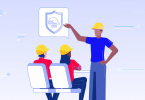
If there is one thing that holds true for developing eLearning training materials, it’s planning, planning and planning. You can’t go wrong with that one. Think of a training course a result of relentless hard work and dedication. In fact, it’s not uncommon to spend 40 hours to develop a course to yield only 2 hours of training time.
With this perspective, we need to make sure we plan in detail, we plan with all details and we rule out unnecessary details. In short, make the planning stage the longest step in eLearning course design! Wow, that’s a lot of pressure! But it’s true. Think of all the trainings left untouched or uncompleted in your learning management system. Why, despite hiring the best eLearning consultants and even applying your own training management skills, some courses never make it to better testimonials and performance spikes? What key steps need to be executed in the planning stage to ensure the effectiveness and success of your corporate training materials?
Let’s find out and try it for ourselves!
The Real Heroes: Human Resources
The human resource department has a rich information on each employee, their aspirations and their needs. It can also aid in revealing the bottom line of your organization – the immediate and long-term growth goals and current potential. Leverage your training material planning phase with an HR personnel.
Determine Organization Business Processes
The HR of your organization is the correct place to start analyzing your corporate training needs. Discuss the corporate functional and operational strategy. Are there any changes made recently? Create a concise training strategy statement with the aid of HR personnel responsible for policy and manual development.
Any latest research and development that would affect your corporate strategy? What about defining the type of business processes dominantly engaged by your organization? Are you a product oriented, a service oriented or a performance oriented organization?
Narrow down your organization activities in this way. This will help determine the type of training and development plan you need to develop. For instance, technical training usually needs simulations, service improvement training usually need scenario-based decision making, and product training requires detailed tutorials on the product.
Determine Performance Needs
When we talk about performance, the first tool that comes to mind are the KPI’s (key performance indicator). The HR department will have a list of updated KPIs that need to be integrated into training materials.
KPIs quantitatively measure the performance of the employees, for example, number of customers per month, number of products sold per month, number of complaints handled per month, number of lost registrations per month, etc. These figures hold valuable input for your planning phase.
What will the employees do after completing the course? How will their learning affect the KPIs? Aligning training goals with corporate KPIs is the smartest way to create effective eLearning material.
Determine Employee Performance
Most training crash upon launching because they are only organization focused. Omitting the individual learning needs of your employees during the planning phase will cost you in the long-run. It is the employees who will inspire other employees to take the training.
Analyze the employee training barriers – what factors prevent them to train on time? Is the content relevant to their job description? If not, have you explained the value of the extra content? Is the content organization violating the cognitive overload theory (providing too much information in one screen). Are you “showing” most of the time as compared to “telling”? Does your content have engaging multi-media and intelligent interactive components? Are you providing training incentives (recognition, awards, online mentoring opportunity etc?).
Remember, your aim is to boost employee performance and organization-wide ROI (return on investment). Keep into account the adult learning theories that describe the effective methods of tackling training programs. Determine the performance of the employees (As evaluated by managers post-training) and measure it with corporate performance needs. Is there a gap? What areas does the gap specify?
Custom-tailor your training materials according to these gaps. Not only will your training development efforts remain focused, your training materials will be targeted and relevant to both the employee and the organization.
Develop Corporate Training Strategy
This is the most crucial step in training analysis and planning phase. After uncovering the above-mentioned information, create a formal Corporate Training Strategy. Involve all stakeholders who are the key enablers in approving the budget for the training materials. An Online Corporate Training Strategy is a dynamic training philosophy that reflects the business practices, business culture, external environment, laws, policies and innovative technologies/practices.
Needless to say, the Corporate Training Strategy is a result of extensive research and analysis and rigorous peer reviewed document. Make it your cardinal rule to refer to this document before developing any training materials.
Determine Delivery Methods
Ensure your training delivery is mobile and laptop friendly. Take into account the language and jargon barriers. Translate and provide glossary whenever possible. Depending on the trainees, determine their technology preference.
Are they too busy with meetings and unexpected calls to attend structured, blended training? Will they prefer asynchronous learning materials? What has worked in the past? Did you gather any explicit trainings preferences through surveys? Are your trainees game-oriented? Maybe ice-breakers and case-studies will motivate and engage them into the training. Maybe it’s a puzzle or a mystery they need to solve as group. Maybe team development and team trust is the main issue that prevents success in training.
Understanding and empathizing with group and team-level needs will help determine training delivery preferences. Above all, check with your organization resources. What learning management system is in place and does it support blended and online learning? Most employees enjoy talking about their learning experience. Channel this productive talk using the collaborative features of your LMS. Observe and mentor communications based on newly acquired training. Determine what needs to go into the training material in order to improve it for the next iteration.
Planning and improving training in iterations is the sure-fire method to power up trainings that yield performance.




